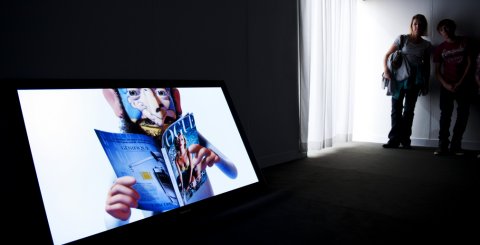
The highlight of London’s art calendar: Frieze Art Fair
Juste Kostikovaite
25/10/2011
October is the month to be in London. Frieze Art Fair attracts not only collectors and galleries, but is also a catalyst for the huge amount of happenings, openings, screenings, performances and other events going on around the city. Everything seems to be happening at the same time, as if all of the events are trying to grab a piece of the same crowd. The central axis for all of these events, of course, is Frieze Art Fair, with the charm of Regent’s Park and its bright lights and white booths.
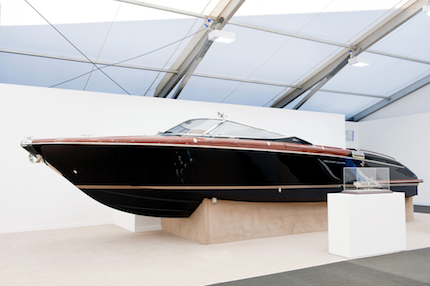
Christian Jankowski. The Finest Art on Water. 2011
Photo: Frieze Art Fair
Would you swap your credit card for a piece by Michael Landy, or would you prefer a 65 million euro yacht?
After a couple of hours of strolling through the booths in Frieze, one gets tired. Professionals select the artists whom they have been following and then quickly run to their particular booths. But Frieze is not just an event for collectors or other professionals – it's also a fascinating place for ever-curious visitors. At each fair, there are always a few artworks that really draw the crowds. This year, one of those was Michael Landy's interactive installation,“Credit Card Destroying Machine”. In 2010, “Credit Card Destroying Machine” was commissioned by Louis Vuitton (LV). The work is a moving sculpture, made from vintage objects – such as old scissors, rusty saws, body parts of dolls – all of which move and make noises when activated. When connected to electricity, the sculpture produces drawings. After a drawing is made, the animated sculpture is “fed” the “customer’s” credit card; it then breaks the card into little pieces, forming a pile on the ground.
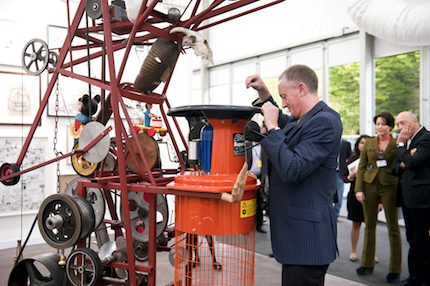
Michael Landy. Thomas Dane Gallery. 2011
Photo: Linda Nylind / Frieze Art Fair
At first glance, this work is a rather simple example of institutional critique. It raises many questions which are not quite new, but are, nevertheless, still relevant. Firstly, the work plays with the opulent, luxury – and consumerist – image of the LV brand. What kind of powers are at play that one is willing to give out his/her money in order to get a branded, ugly handbag from LV? Secondly, the work laughs at the incredible prices that circulate at auctions and art fairs. Thirdly, it points to the factory-like production mode of the YBA (Young British Artists) group, such as Damien Hirst, a well known artist-entrepreneur who has such a growing demand for his artworks that he must literally create factories to produce them. >>
Christian Jankowski's art yacht
Another much-talked-about artwork is Christian Jankowski's art yacht, with a price tag of 65 million euros. In conjunction with the luxury yacht manufacturers CRN and Riva, Jankowski’s project, “Finest Art on Water” is presented as a luxury product available for purchase not only as a boat, but also as a work of art by Christian Jankowski. The potential client can enter the salon to see the interior and hear descriptions of the yacht/artwork.
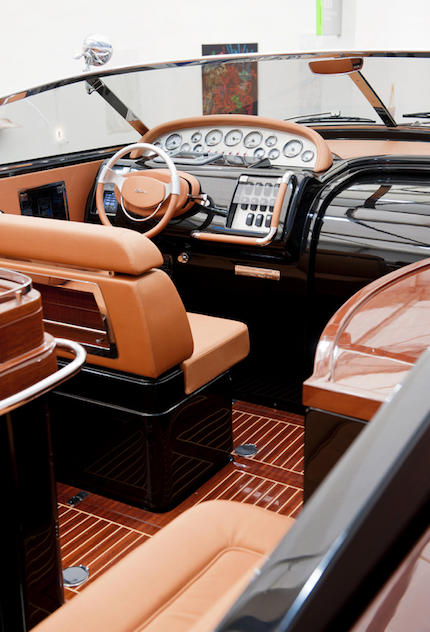
Christian Jankowski. The Finest Art on Water. 2011
Photo: Frieze Art Fair
Working in various mediums, such as film, video, performance and installation, Jankowski’s work is always intrusive and collaborative. Jankowski creates situations wherein the response of the audience determines if they do or don't become “part”of the artwork. It is precisely these reactions of involved/reactive, people that make up the core of his work.
The “Finest Art on Water” project finger-points at art collectors or, rather, at that certain filthy-rich art-buyer image. But is it news to anyone that the art market is rich and crazy?
The real news here is that Frieze allows for internal critique. This is in addition to Frieze's gestures of providing resources and organizing talks and screenings. In so doing, the Frieze creates a platform for thinking, screening, sharing and publishing. And, just as most of the major art institutions in the last decade have done, it shows responsibility – a feature now practically demanded by audiences.
Art, Death and Heaven

Elmgreen & Dragset. Galerie Perrotin
Photo: Linda Nylind / Frieze Art Fair
Another worst – and best – work spotted at Frieze is Elmgreen's and Dragset's untitled, life-sized morgue wall and dead body sculpture at the booth of Galerie Emmanuel Perrotin. “Buy or die!”, shouts the sculpture. Occasionally, a gallery rep will jump out through the doors of the installation's “morgue” (where the “dead bodies” are placed), giving a startling, albeit funny, assurance that she's not part of the artwork. >>
+++pagesplit+++
The Standard gallery (Oslo) creates a small oasis among the surrounding booths by displaying a carpet by Marius Engh, which covers most of the booth's floor.
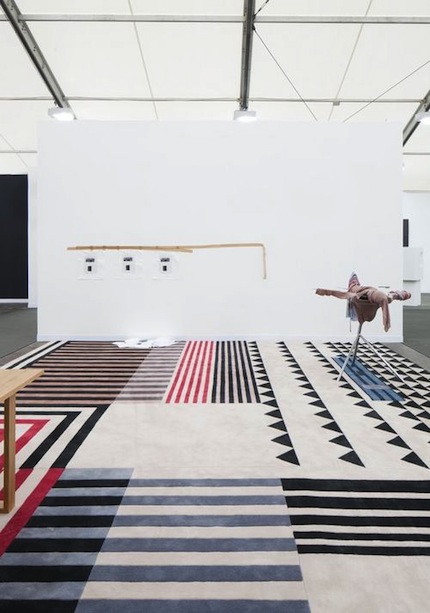
Photo: Standard gallery (Oslo)
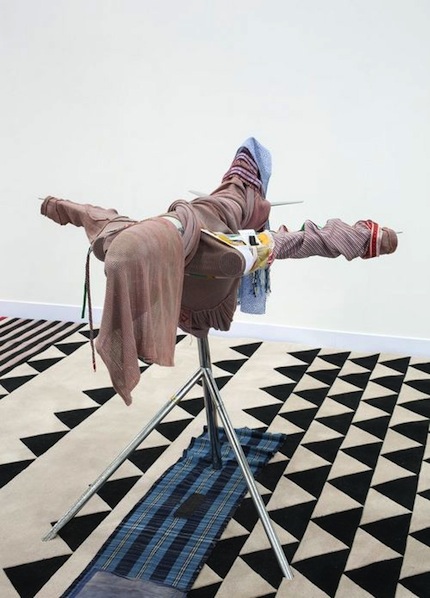
Photo: Standard gallery (Oslo)
It is a very experiential and conceptual artwork, as the visitor immediately finds out just by stepping on the material of the soft, thick carpet. The work is called “Victory over the Sun” (€30,000), created in 2011. It is a re-creation of the centerpiece of the 1975 film, “Salò, or the 120 Days of Sodom”, by the Italian director, Pasolini. Standard’s booth has no inner walls and occupies the space of two booths, leaving the impression of a very large space.
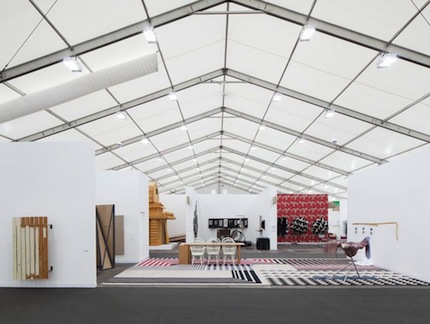
Photo: Standard gallery (Oslo)
Despite all of the games with luxury and works about death (Elmgreen and Dragset), there aren't that many controversial works to see this year. According to spoonfed.co.uk, vaguely noticeable trends include “over-painted newspapers, explorations of the suburban, and baffling pseudo-scientific systems (with graph paper)”. Painting dominates and there are more smaller scale works on paper than usual. And as always: direct, flashy, loud and showy works take over.
Friendly Sunday Art Fair is back
A fair running concurrently near Frieze is the SUNDAY art fair, established by London’s “Lemoncello”, Brussels'/Vilnius' “Tulips&Roses” and Berlin’s “Croy Nielsen” galleries. The impact that the fair has made is clearly visible – in some publications, it is already being called “Frieze's most dangerous rival”.
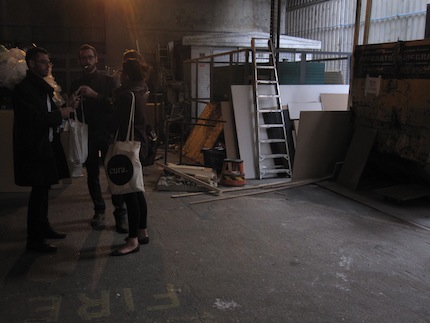
Entrace to SUNDAY art fair
Unlike the whopping 25 GPB entry-fee for visiting Frieze, SUNDAY art fair is free. The form of the fair has an exhibition-like feeling. There are no booths, as galleries are separated by only barely visible lines. Although one may want to call it an exhibition, it is still an art fair. SUNDAY has its signature “location scouting” – it always chooses central locations which either have layers of history or are in the process of transition. SUNDAY used a newly-built, unfurnished building in the heart of Berlin at Rosa-Luxemburg Platz, while in London, SUNDAY is currently located in a hangar-like warehouse at Ambika3.
Artists featured in this fair are: Ryan Gander, Christian Jankowski, Jessica Warboys, Sean Edwards, Simon Fujiwara and Raimundas Malašauskas, among others.
The concept and development of this accessible and temporary platform has proven to be quite successful, since this is SUNDAY's third showing in Europe already. SUNDAY borrows a lot from diy culture, where peers work together and form new platforms through collective action, less advertising and an anti-pompous appearance.
www.friezeartfair.com
sunday-fair.com